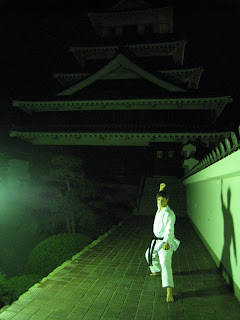 Often, at the Saturday class, Tachibana Shihan tells us to each select a kata we individually wish to work on. Last Saturday, after jiyu-kumite, I decided to do a kata which I’ve been neglecting for a fair while. The three Shotokan-ryu kata which initially came to mind were Jiin, Chinte and Wankan, I randomly chose to do Chinte, and certainly do not regret this decision! The tips, and corrections I received, turned out to be priceless.
Often, at the Saturday class, Tachibana Shihan tells us to each select a kata we individually wish to work on. Last Saturday, after jiyu-kumite, I decided to do a kata which I’ve been neglecting for a fair while. The three Shotokan-ryu kata which initially came to mind were Jiin, Chinte and Wankan, I randomly chose to do Chinte, and certainly do not regret this decision! The tips, and corrections I received, turned out to be priceless.Techniques polished by Shihan included the tate shuto uke in fudo-dachi hanmi followed by tate zuki in zenkutsu-dachi shomen; teisho soto uke moving into fudo dachi hanmi followed by teisho hasami uchi into zenkutsu dachi shomen; ryo sho sokumen gedan barai; seiken hasami zuki; and the three infamous hops, which conclude the kata. Each of these techniques were analysed from an oyo-jutsu (technique application) viewpoint, and this was perfectly related to the standard JKA-Shotokan form. I have to say that this bunkai, and co-adherence to the classical form, was a "real treat" for me... Phenomenal! It was by far the very best tuition I’ve ever received on Chinte kata.
___________
The tuition I received during this training session made me re-evaluate my view of Chinte, and more importantly, further open my mind to other kata, which I've been neglecting. Such experiences fo r me really establish why 'I'm living in Japan'. It is insufficient to simply come here to train for a couple of weeks (like so many do and brag about it). In reality you need to be in Japan, training daily, for at least a month, merely to get 'a feeling' of traditional Japanese karate-do, and ideally train here for many years, under an 8th or 9th Dan Shihan.
r me really establish why 'I'm living in Japan'. It is insufficient to simply come here to train for a couple of weeks (like so many do and brag about it). In reality you need to be in Japan, training daily, for at least a month, merely to get 'a feeling' of traditional Japanese karate-do, and ideally train here for many years, under an 8th or 9th Dan Shihan.
 r me really establish why 'I'm living in Japan'. It is insufficient to simply come here to train for a couple of weeks (like so many do and brag about it). In reality you need to be in Japan, training daily, for at least a month, merely to get 'a feeling' of traditional Japanese karate-do, and ideally train here for many years, under an 8th or 9th Dan Shihan.
r me really establish why 'I'm living in Japan'. It is insufficient to simply come here to train for a couple of weeks (like so many do and brag about it). In reality you need to be in Japan, training daily, for at least a month, merely to get 'a feeling' of traditional Japanese karate-do, and ideally train here for many years, under an 8th or 9th Dan Shihan. OSU, André.
__________
© André Bertel, Japan 2008
© André Bertel, Japan 2008
No comments:
Post a Comment